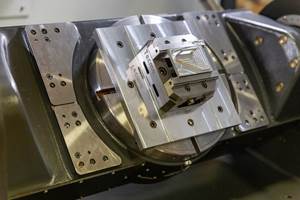Red, Yellow, Green
Data-driven manufacturing should be color-coded for simplicity.
Share





Data-driven here. Data-driven there. Internet of this. Internet of that. Industry 3.0, 4.0, 5.0 (Who’s in charge of counting this, anyway?). Computing in the cloud, in the fog, in the mist, at the edge, at the core. It can all seem a little crazy.
So let’s step back and remember that it is all about Red, Yellow, Green. Red signals that a machine is not running. Yellow signals that a machine may need help to keep running. Green signals that a machine is running—for now.
It’s that simple. Getting everyone in the company to have a Red, Yellow, Green mentality would get the entire organization focused on what really counts: what is (or is not) happening on the shop floor. By company, I mean any manufacturing enterprise, from the family job shop to the global conglomerate. By everyone, I mean the CEO and the Board of Directors all the way to the shopfloor staff—machine operators, CNC programmers, toolroom attendants and so on. Engineering, Sales, IT, HR and all levels of management must be focused on Red, Yellow, Green as well.
Of course, the significance of these colors is different from person to person in the company. Each color represents a spectrum of meaning, nuances, and degrees of urgency or alertness. Each color is a constant call to action that covers a range of decisive responses and levels of empowerment. Not doing something may be as valid a response as hitting the emergency stop button, as long as the rightness of the response is equally clear and unequivocal.
Here are some more thoughts on keeping Red, Yellow, Green in mind.
The need to know is basic. A huge benefit of connecting machines to a network is making these colors and their meanings visible to the entire enterprise. This is unifying and energizing.
Take it personally. Everyone must be responsible for reacting to Red, Yellow, Green in their particular spheres. It should be a top management priority to instill and enforce this responsibility. Those rascals in IT, for example, must act as key enablers of this organizational principle.
Red is a friend. Never ignore a friend. Red sets priorities, governs resource allocations, teaches lessons and validates lean manufacturing efforts. Red means GO! There are good and bad reasons for a machine not to be running. The right attention to Red is what matters.
Watch out for Green. The temptation is to allow Green to mean STOP—stop watching, stop looking for hidden waste, stop thinking about what’s next. Green is linked to high productivity and a desirable overall equipment efficiency (OEE) rating, but it must also be linked to profitability.
It’s a numbers game. These color-coded visual signals always point to numerical values. The intent of data-driven manufacturing is to give decision-makers the numbers needed to act in ways that improve manufacturing processes. No guesses. No assumptions.
Moving to data-driven manufacturing, the Industrial Internet of Things or Industry 4.0 is not easy. Thinking Red, Yellow, Green should prevent unfocused thinking from adding complexity to the urgent, demanding task at hand: getting the most from the machines on the shop floor.
Related Content
Diving Deeper Into Machine Monitoring Data
Data visualization is the first step in using machine monitoring data, but taking it to the next level requires looking for trends within the data.
Read MoreFour Questions (& Answers) About Data-Driven Process Improvement at CNC Job Shops
How can shops can make informed decisions using data-driven feedback to improve shopfloor efficiency and profitability? And how will these technologies differ between high- and low-volume production?
Read MoreGive Job Shop Digitalization a Customer Focus
Implementing the integrated digital technologies and automation that enhance the customer's experience should be a priority for job shops and contract manufacturers.
Read MoreHow this Job Shop Grew Capacity Without Expanding Footprint
This shop relies on digital solutions to grow their manufacturing business. With this approach, W.A. Pfeiffer has achieved seamless end-to-end connectivity, shorter lead times and increased throughput.
Read MoreRead Next
Setting Up the Building Blocks for a Digital Factory
Woodward Inc. spent over a year developing an API to connect machines to its digital factory. Caron Engineering’s MiConnect has cut most of this process while also granting the shop greater access to machine information.
Read More5 Rules of Thumb for Buying CNC Machine Tools
Use these tips to carefully plan your machine tool purchases and to avoid regretting your decision later.
Read MoreRegistration Now Open for the Precision Machining Technology Show (PMTS) 2025
The precision machining industry’s premier event returns to Cleveland, OH, April 1-3.
Read More






















.jpg;maxWidth=300;quality=90)








